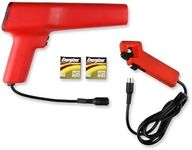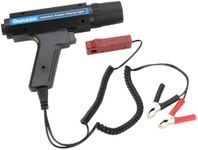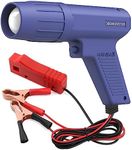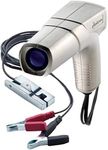Buying Guide for the Best Timing Lights
Choosing the right timing light is important for anyone working on car engines, especially if you want to keep your engine running smoothly and efficiently. Timing lights help you check and adjust the ignition timing, which is crucial for engine performance, fuel efficiency, and preventing engine damage. When picking a timing light, it's important to understand the main features and how they relate to your needs, whether you're a hobbyist or a more serious DIY mechanic.Type (Basic, Advance, Digital)The type of timing light refers to its complexity and features. Basic timing lights are simple and usually just flash when the spark plug fires, making them easy to use for standard timing checks. Advance timing lights allow you to dial in the timing advance, which is useful for engines with adjustable timing or for more precise tuning. Digital timing lights often have extra features like digital readouts and memory functions, making them suitable for those who want more detailed information. If you just need to check timing occasionally, a basic model is fine. If you plan to tune or modify engines, an advance or digital model will give you more control and information.
Power SourceTiming lights are usually powered by either the car's battery (using alligator clips) or by internal batteries. Battery-powered models are more portable and convenient if you work away from a car battery, but they may not be as powerful or long-lasting. Models that use the car battery are more common and reliable for regular use. If you work mostly in a garage or near a car, a model that clips to the battery is a good choice. If you need portability, consider a battery-powered option.
Inductive PickupThe inductive pickup is the clamp that attaches to the spark plug wire to sense the ignition signal. Most modern timing lights use an inductive pickup because it's safer and easier than older direct-connect styles. The quality and sensitivity of the pickup can affect how well the timing light works, especially on engines with weak ignition signals. For most users, a standard inductive pickup is sufficient, but if you work on older or high-performance engines, look for a model with a sensitive and reliable pickup.
Brightness of the Strobe LightThe brightness of the strobe light determines how easy it is to see the timing marks, especially in bright daylight or on dirty engines. Brighter lights make it easier to get an accurate reading. Some timing lights have adjustable brightness or use xenon bulbs for extra visibility. If you often work outdoors or in well-lit areas, choose a timing light with a strong, bright strobe.
RPM and Advance ReadoutSome timing lights can display engine RPM and the amount of timing advance, either on a dial or a digital screen. This feature is useful for more advanced tuning and for checking timing at different engine speeds. If you only need to check base timing, you may not need this feature. If you want to fine-tune your engine or work on performance vehicles, a timing light with RPM and advance readout will be helpful.
Durability and Build QualityDurability refers to how well the timing light can withstand drops, grease, and regular use in a garage environment. A sturdy, well-built timing light will last longer and be more reliable. Look for models with solid construction, good-quality cables, and a comfortable grip. If you plan to use your timing light frequently or in tough conditions, prioritize durability.

















